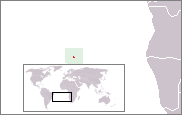Saint Helena earwig
| Saint Helena earwig | |
|---|---|
 | |
| Scientific classification | |
| Kingdom: | Animalia |
| Phylum: | Arthropoda |
| Class: | Insecta |
| Order: | Dermaptera |
| Family: | Labiduridae |
| Genus: | Labidura |
| Species: | L. herculeana |
| Binomial name | |
| Labidura herculeana (Fabricius, 1798) | |
 | |
| Location of Saint Helena | |
The Saint Helena earwig or Saint Helena giant earwig (Labidura herculeana) was a large species of earwig endemic to the oceanic island of Saint Helena in the south Atlantic Ocean.[2] It is now considered extinct.[1]
Description
Growing as large as 84 mm (3.3 in) long (including forceps), the Saint Helena earwig was the world's largest earwig. It is shiny black with reddish legs, short elytra and no hind wings.[3]
Distribution and ecology
The earwig was endemic to Saint Helena, being found on the Horse Point Plain, Prosperous Bay Plain, and the Eastern Arid Area of the island. It was known to have lived in plain areas, gumwood forests and seabird colonies in rocky places. The earwig inhabited deep burrows, coming out only at night following rain. Dave Clark of the London Zoo said that "[t]he females make extremely good mothers".[4]
History
The Saint Helena earwig was first discovered by Danish entomologist Johan Christian Fabricius in 1798. It later became confused with the smaller and more familiar shore earwig Labidura riparia, and received little attention from science. It was all but forgotten until it was rediscovered in 1962 when two ornithologists, Douglas Dorward and Philip Ashmole, found some enormous dry tail pincers while searching for bird bones. They were given to zoologist Arthur Loveridge who confirmed they belonged to a form of huge earwig, and the species was named L. loveridgei.
In 1965, entomologists found live specimens in burrows under boulders in Horse Point Plain. While they were thought to be L. loveridgei, once examined they were found to be the same species as L. herculeana, and this was reinstated as their official scientific name. Other searches since the 1960s have not succeeded in finding the earwig,[5] and it was allegedly last seen in 1967.[1]
On 4 January 1982, the Saint Helena Philatelic Bureau issued a commemorative stamp depicting the earwig, which brought attention to its conservation.[6] In the spring of 1988, a two-man search called Project Hercules was launched by the London Zoo, but was unsuccessful.[5] In April 1995 another specimen of earwig remains was found. It proved that the earwigs not only lived in gumwood forests but, before breeding seabirds were wiped out by introduced predators, they also lived in seabird colonies.[7]
Conservation status
The earwig has not been seen alive since 1967 despite searches for it in 1988, 1993 and 2003. It is possibly extinct due to habitat loss as well as predation by introduced rodents and an introduced centipede, Scolopendra morsitans. In 2014, the IUCN changed their assessment of L. herculeana on the IUCN Red List from Critically Endangered to Extinct.[1]
References
- 1 2 3 4 D. Pryce & L. White (2014). "Labidura herculeana". IUCN Red List of Threatened Species. Version 2014.3. International Union for Conservation of Nature. Retrieved November 30, 2014.
- ↑ "Giant earwig". Insects and Spiders of the World. 4. Tarrytown, NY: Marshall Cavendish Corporation. 2003. p. 236. ISBN 0-7614-7338-6.
- ↑ "Labidura". St Helena and Ascension Island Natural History. Archived from the original on February 5, 2011. Retrieved February 5, 2011.
- ↑ Worthington, P. (1988). "Over there, the topics ring all sorts of bells". Financial Post. p. 14.
- 1 2 Shuker, Karl (1993). The Lost Ark. Harper Collins. pp. 235–236. ISBN 0002199432.
- ↑ Benson, Sonia; Nagel, Rob, eds. (2004). "Earwig, Saint Helena Giant". Arachnids, Birds, Crustaceans, Insects, and Mollusks. Endangered Species. 2 (2nd ed.). Detroit: UXL. pp. 482–483. ISBN 9780787676209.
- ↑ "The Invertebrates of Prosperous Bay Plain, St Helena: a survey" (DOC). St Helena and Ascension Island Natural History. Retrieved February 5, 2011.
External links
| Wikimedia Commons has media related to Labidura herculeana. |
| Wikispecies has information related to: Labidura herculeana |
- The Giant Earwig of St. Helena – The Dodo of the Dermaptera
- "It's giant earwigs versus aircraft on remote St Helena"
- "The giant earwig that could bring a country to a standstill"
